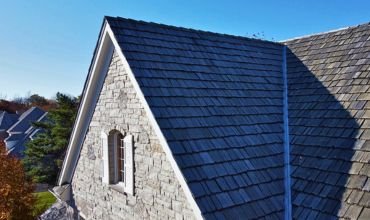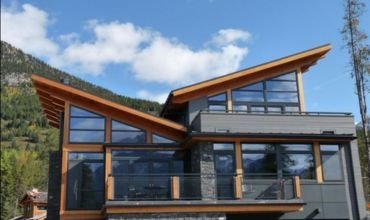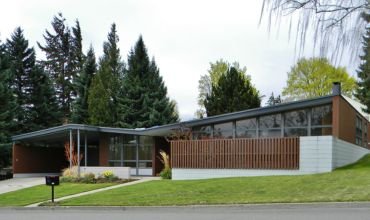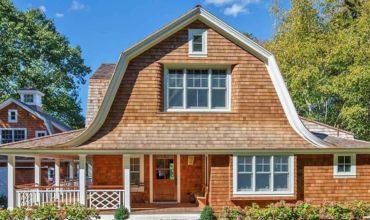Contemporary design is an extraordinary field of architecture that adapts trends, minimalist designs, technological advancements, and societal needs. One captivating aspect of contemporary house design with slanted roof is how it enhances both aesthetic appeal and functionality while considering sustainability and a connection to nature.
If you are thinking of choosing a slanted roof house this time, then you are at the right place. In this blog, we will cover all the elements you need to know about slanted roofs and delve into the various facets of contemporary house design, exploring their benefits, styles, and how they enhance the look of your home. house design while exploring their benefits, styles, and the way they enhance the look of your home.

The sloppy-slanted roofs are much more than a downward-going shelter. Before diving into learning more about slanted roofs and looking at more of their details, here’s what you can expect from your contemporary house design with slanted roof :
Slanted roofs are a great choice if one wants to enhance their architectural choices. Compared to flat roofs, slanted roofs give a feeling of progression and flow, often while guiding the eye upwards toward the sky. This upward motion might represent creativity and aspiration, which is in line with modern design ideals.
Architects use different materials—such as wood, metal, or shingles—to enhance the visual texture of slanted roofs, according to the customer’s choice. For example, a wooden slanted roof can impart warmth and organic beauty, while a sleek, metallic surface might evoke a modern, industrial feel. The choice of material with color variations often gives freedom to choose unique styles and structures, ensuring every homeowner finds a design that resonates with their personal aesthetic.
One of the most compelling advantages of slanted roofs is that they provide maximized natural light, often making them a slanted roof sun room. The angles of the roof facilitate the incorporation of large windows, skylights, and clerestory windows. For example, skylights let an abundance of natural light into the house, which expands the feeling of space and coziness in rooms like living rooms and kitchens. Additionally, they can greatly lessen the use of artificial lighting during the day, which helps save energy.

In an era increasingly focused on sustainability, the design of slanted roofs can contribute to energy efficiency in multiple ways. Sloped designs help prevent water drainage, minimizing the risk of leaks and water damage, which is beneficial for regions with heavy rainfall or snowfall.
Additionally, the shape of a slanted roof can promote natural ventilation. Warm air rises and escapes through the higher points of the roof, creating a cooling effect in the lower areas of the home. Especially in warmer climates, this natural circulation can lessen the need for air conditioning equipment, which can lead to lower energy costs and a smaller carbon footprint.
Slanted Roofs can significantly impact a home’s interior layout, creating unique opportunities for space optimization. For example, a bedroom with a slanted ceiling can make the area feel warm and inviting while still using the vertical space for cupboards or shelving. This flexibility is particularly valuable in urban environments where maximizing space is essential. Lofted areas can serve as additional bedrooms, home offices, or recreational spaces, making the most of every square foot.
As versatile as Slanted roofs are, they promote a variety of unique styles and structures. For people who are looking for a classy Gothic-modern aesthetic, this can be a cherry on top. Here are a few prominent styles that utilize this element.
Minimalism is often referred to as the embracement of simplicity and functionality, often characterized by clean lines and open spaces. Sharp angles and monochrome color schemes are common features of slanted roofs in minimalist architecture. These roofs’ interplay of light and shadow can improve the minimalist look by giving the design depth without being overbearing.
The Germanic-inspired design, also known as Scandinavian, is known for its natural materials, light, and functionality. Slanted roofs in this style are often steep and covered with wooden shingles or metal, complementing the serene, organic vibe. The design prioritizes large windows that invite natural light, creating bright and airy interiors that reflect the beauty of the surrounding landscape.

The modern movement of the mid-1900s emphasized strong ties to nature and geometric shapes. This design is typified by slanted roofs, which are frequently seen in angular homes with large glass walls. These designs blur the distinctions between the internal and outdoor settings and promote indoor-outdoor life.
The sustainable nature of slanted roofs utilizes roofs to maximize energy efficiency and ecological impact. Homes designed with passive solar principles often feature slanted roofs angled to capture sunlight and facilitate natural ventilation. These homes prioritize renewable energy sources, water conservation, and materials that have a minimal environmental footprint.
Modern aspects are combined with old components in rustic contemporary design. This type of slanted roof frequently uses materials like stone or salvaged wood, which gives a house a cozy, welcoming atmosphere. The angle of the roof can produce intriguing overhangs that improve outdoor living areas by offering protection and shade.
The needs and use of slopes may vary according to unique preferences and circumstances. In that case, slanted roofs come in different types, which homeowners can look for according to their tastes.
Among all the other types of slanted roofs, the most commonly used are the gable ones, as they are versatile in nature and can stand up to most of the requirements of what a roof should be like. This kind of sloping roof is commonly used in the residential sector. Different materials are available for homeowners to make this roof. When creating such roofs, architects take extra care to avoid 45-degree angles. This complies with industry requirements and norms. Architects shorten outside walls in this way. As a result, the roof receives increased attention. It also provides the property with a more aesthetically pleasing and well-balanced appearance.
It is safe to refer to the saltbox roof as a gable roof’s offshoot. A gable roof and this sort of sloping roof are nearly identical. The length of the roof panels that make up the ridge varies. One side is longer than the other in this style. It offers the home a unique identity all its own. Independent homes typically have these kinds of roofs. They are a byproduct of buildings designed in the 20th century. Our professionals advise that this roof also aims to create a steeper roof. Better results in terms of architectural integrity are obtained by doing this.

The Gambrel roof is another common type of sloping roof. Homeowners adore this! On each side, there are two identical roof panels. But unlike other types of sloping roofs, they are not oriented in a straight line. A gambrel roof has two slopes, as the small image above illustrates. The home is essentially the same, but the roof slopes are different. The Dutch origins of this roof were noted by our specialists. One major benefit of this sort of roof slope is that it preserves all the features of a sloped roof while adding more space to the top portions of the house.
Another name for a mansard roof is a four-slope side roof. This is a result of its four sloping sides. That is how it is comparable to the Gambrel roof. The slope on all sides is what makes a difference. These sloping roof styles have a form that makes the higher floors of the home visible only from a distance. Our specialists remind out that these roofs have French roots. Mansard actually means “attic space” in its literal sense. Its relative, the Gambrel roof, is likewise more well-known in European nations.
Pyramid roofs and their cousin, Mansard roofs, are similar in that they have four sides to their slope. These roofs have a pyramidal form. These are perfect for smaller structures like sheds, garages, and so forth. These kinds of roofs are common in modern buildings. This is because they are simple to construct and well-balanced. These roofs nevertheless produce the greatest roofing outcomes even if they have a modest slope on all sides. According to our specialists, these roofs also increase a building’s energy efficiency.
While slanted roofs offer numerous advantages, there are practical considerations that homeowners and architects should keep in mind, which can lead them to avoid any future discomfort and loss of money; here’s what to look for:
The design and pitch of a slanted roof should consider the local climate. For example, In regions with heavy snowfall, a steeper pitch may be necessary to prevent snow accumulation, while flatter pitches might suffice in drier climates. Understanding local weather patterns can guide the design process to ensure durability and performance while saving you from the Secret Service slanted roof.
Before embarking on a contemporary home design with a slanted roof, it’s essential to research local building codes and regulations. Some municipalities have specific guidelines regarding roof pitch, height, and materials. Engaging with local authorities early in the design process can help avoid potential setbacks.

Slanted roofs can be easier to maintain than flat roofs due to better water drainage. However, the choice of materials can impact maintenance requirements. For instance, metal roofs may require less upkeep than wooden shingles, which can be susceptible to rot and pests. Consideration of long-term maintenance will ensure the roof’s longevity and performance.
The cost of building a home with a slanted roof can vary based on design complexity, materials, and labor. While some may perceive slanted roofs as more expensive, the potential for energy savings and reduced maintenance can offset initial costs over time. Collaborating with an architect or builder to explore budget-friendly options while achieving the desired aesthetic can be beneficial.
Slanted roofs are a stylish and useful feature of modern home architecture. Both architects and homeowners favor them for their capacity to increase energy efficiency, optimize natural light, and improve aesthetic appeal. Slanted roofs may create a welcoming, harmonic atmosphere that blends in with its surroundings, whether a home is situated in a busy urban area or a tranquil rural setting. As we look toward the future of architecture, the slanted roof will undoubtedly continue to inspire creativity and innovation. By embracing this design element, homeowners can enjoy not only stunning visuals but also a sustainable, functional living environment that reflects their values and lifestyle.
The slanted roofs can’t be placed by themselves and hence need a flat surface to attach them to a flat roof on your home then put slanted roofs on top of them.
Sloping roofs are common in all houses because they have better water drainage capacity than flat roofs. We commonly see houses with sloping roofs in hilly areas.
Another name for a sloped roof house is called a mono-pitch roof, which is one with a singular sloping surface.
Sloped roofs are a great choice as they help water slide off quickly, keeping your home dry.
The best part of choosing sloped roofs is that despite many benefits, such as providing ventilation and preventing water drainage, they tend to be less expensive than a flat roof.
Leave a Reply